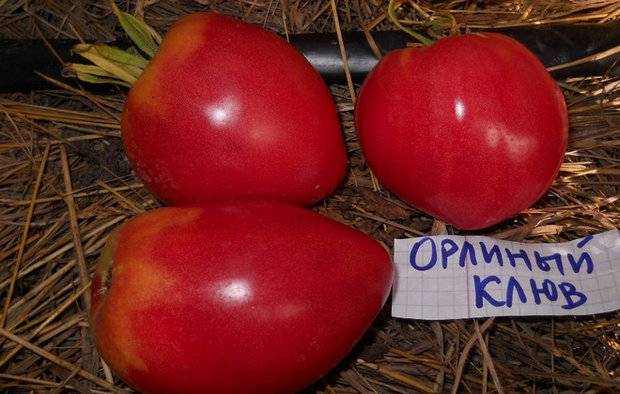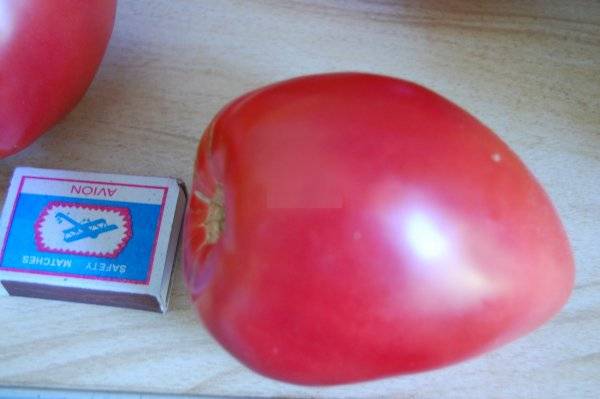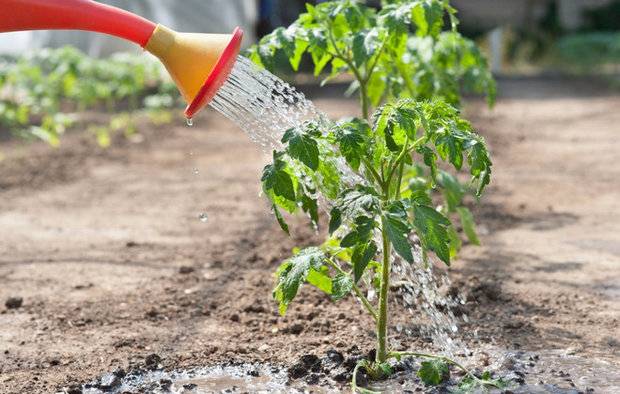Content
Breeders of tomato varieties have bred so many that every vegetable grower can choose a crop with a certain color, shape and other parameters of the fruit. Now we will talk about one of these tomatoes. The Eagle's Beak tomato got its name because of the unusual shape of the fruit, reminiscent of a bird's head. The popularity of the variety is due to its good yield, universal use of the vegetable, as well as its excellent taste.
Getting to know the variety
We will begin to consider the description and characteristics of the Eagle Beak tomato variety by determining the place of its birth. The vegetable was grown by domestic breeders in Siberia. The tomato is able to bear fruit outdoors and in a greenhouse. By the time of ripening, the variety is defined as a mid-season tomato. The plant is indeterminate, spreading, but the stems are rather thin.
A positive feature of the variety is its resistance to cold weather. The short summer and spring night frosts will not interfere with the development of the plant and the formation of the ovary. Fruits have time to fully ripen in the fall. The maximum yield of a tomato is up to 8 kg per bush. The average height of the bush is 1.5 m. The shape of the leaves is common, as is inherent in most tomatoes. The size is large. The foliage is bright green. The formation of inflorescences is most often observed above the tenth leaf.
The length of the stems depends on where the tomato grows. On the street, the bushes usually grow 1.2 m high. Under good care conditions, they reach 1.5 m. In greenhouse conditions, an intensive tomato growth is observed. The bushes can stretch from 1.8 to 2 m in height. Regardless of the growth, tomato stems are tied to a support. The plant cannot be left to its own devices due to the fragility of the branches. They will simply break from the weight of the fruits.
Eagle's Beak tomatoes are tied all summer until autumn, so the harvest takes place in several stages. Usually there are 2-3 phases.
The video provides an overview of tomato varieties, among which there is an Eagle Beak:
Description of fruits
Continuing to consider the photo and description of the Eagle Beak tomato variety, it is worth paying special attention to the fruit. After all, it was his form that gave rise to such a name. The elongated fruit has a narrowing to the apex. The nose of the tomato is slightly elongated and curved, like an eagle's beak. At the initial stage of ripening, the fruit acquires a pink color of flesh and skin. A fully ripe tomato takes on a dark raspberry color.
About tomato Eagle Beak photo, reviews of vegetable growers say that the variety is capable of producing quite large fruits. Typically, these tomatoes are typical for the first phase of the harvest. The weight of the largest fruits can reach 0.8–1 kg. In subsequent phases, the weight of the vegetable is limited to 400 g. For the average, it is customary to take the weight of the fruit - 500 g.In terms of taste, the tomato is characterized as a juicy vegetable with a fleshy sweet pulp. Plucked ripe fruit can be stored for more than a week.
Large tomatoes are used most often for processing and fresh consumption. The tomato is delicious in salads, beautiful in the design of dishes. The sweet flesh allows for delicious juice, thick ketchup and a paste. For whole preservation, the Eagle's Beak is not used.
Advantages and disadvantages of the variety
In summing up the considered description of the Eagle Beak tomato variety, it is worth clearly identifying all the good and bad qualities of the vegetable. Let's start with the benefits:
- the taste of a tomato on a five-point scale gets the highest mark;
- the shape and color of the fruit is quite attractive;
- the variety is characterized by a high yield;
- as for large-fruited tomatoes, keeping quality is normal;
- the variety is resistant to common fungal and viral diseases.
I don't want to pay attention to the shortcomings, but you need to do it. The identified vulnerabilities of the variety in time will help the grower avoid mistakes when growing tomatoes. So, the cons of a tomato:
- like all large-fruited tomatoes, Eagle Beak loves feeding and regular watering;
- stepchildren tend to grow quickly, so you will have to deal with the formation of a bush all season;
- the obligatory garter of tomato stems takes a lot of time, plus you will have to build reliable trellises.
Considering how delicious tomatoes can be grown, the downsides just seem insignificant. With other varieties of tomatoes, there will be no less worries.
Growing tomatoes
To grow a good harvest of tomatoes with large fruits, you need to follow agricultural techniques. The process is quite long and consists of many stages: from seed preparation to harvesting.
Calibrating tomato seeds and preparing them for sowing
You can grow tomatoes from purchased seedlings, but experienced vegetable growers rarely resort to this method. Firstly, it is not known what sort of tomato will be put on the market. Secondly, it is not known what seeds were used to grow the seedlings. One of the important conditions for healthy tomato seedlings is the selection of quality grains. It doesn't matter if they were bought in a store or collected independently from the fruits, the seeds need to be calibrated.
The process involves manual bulkheading of tomato grains, which discards small, broken and rotten specimens. The next step is to immerse the tomato seeds in the saline solution for 15 minutes. During this time, all the pacifiers will float up and must be thrown away. Next, there is the process of etching in a 1% manganese solution, hardening and germination on a saucer under a damp cloth.
Sowing seeds and caring for seedlings
The time of sowing seeds of tomatoes Eagle Beak falls in the month of March. By this time, the grains must have passed all stages of processing and be germinated. It is necessary to calculate so that the finished seedlings will be planted in the garden in 60 days. By this time, constant heat should be established on the street. Sowing tomato grains is carried out in boxes. The soil is suitable from the garden. You just need to bake it in the oven, then mix it with humus.
The prepared soil is poured into boxes and slightly moistened. Grooves are cut on the surface with a finger or any twig in steps of 2-3 cm. The depth of the grooves is from 1 to 1.5 cm. Tomato grains are laid out in steps of 1.5-3 cm, after which they are covered with a thin layer of loose soil and moistened with a spray bottle. The boxes are covered with foil on top. In this state, they stand until the tomato germinates. After that, the film is removed, and the boxes with seedlings are placed in a bright place. Lamps are used for additional illumination.
When two full-fledged leaves grow on the tomatoes, the plants dive into the cups. Here the tomatoes will grow before they are planted in the garden. Immediately after the pick, the tomatoes are placed in a shaded place.When they get stronger, you can bring it back into the light. A week before planting in the ground, tomatoes are hardened, taking them out into the street.
Landing in the garden
The Eagle Beak tomatoes are planted in the garden when the weather is warm outside and the soil has warmed up. Usually the procedure falls on the last days of May or early June. By this time, the soil in the garden must be etched, loosened and humus added. For tomatoes, make holes at a distance of at least 50 cm from each other. 1 tbsp is introduced into the soil of each hole. l. phosphorus and potash fertilizers. Sprinkle the roots of tomatoes with loose soil to the level of the cotyledon leaves. After planting, each tomato is watered with warm water.
Caring for plantings of tomatoes
The Eagle Beak variety loves abundant watering. The frequency depends on weather conditions, but at least once a week. Tomatoes are fed with fertilizers containing minerals at least three times per season. Well suited: "Plantafol", "Kemiru" or just ammonium sulfate. Organic matter can be added more often. Tomatoes are favorably disposed to such top dressing. Any waste from vegetables, eggshells, straw will do. But feeding the tomato with bird droppings must be done carefully. If you overdo it, the plants can burn out.
The formation of tomato bushes involves the removal of all unnecessary stepsons. Usually one or two stems are left. Leaves from the lower tier are also cut off. If there is a thickening of the bush with green mass, the leaves are partially removed at each tier. Thinning frees the fruit for sun exposure. The formation of tomato bushes begins in July. The frequency of the procedure is maximum 10 days. The garter is carried out to the trellis. To make this easier to do, tomatoes are planted in rows. Pillars are driven in along the edges, and ropes or wire are pulled from them.
Of all the troubles that can happen to the Eagle Beak variety, an outbreak of late blight can be distinguished. This disease is better prevented by prophylactic spraying with Bordeaux liquid solution. In the event of the appearance of a fungus, the plantings are treated with Fitosporin. A soap solution or a decoction of celandine will help fight harmful insects.
Testimonials
Vegetable growers have always had only good reviews about the Eagle Beak tomato. Even a beginner can grow the variety. You just need to follow the slightest rules of agricultural technology. As proof, let's find out what gardeners think about this tomato.
















